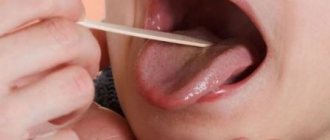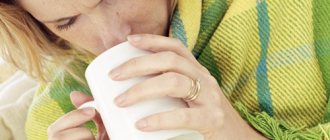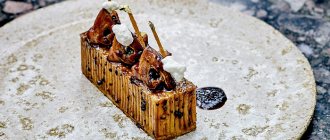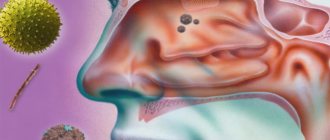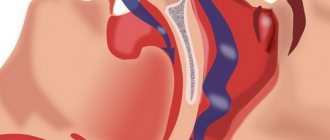Gargling with salt water
Saline rinse is a proven home remedy with antibacterial, decongestant, disinfectant, soothing and anti-inflammatory effects. It is not without reason that many doctors and pharmacists recommend gargling with a saline solution as the first step in self-treating minor throat irritations.
In other words, gargling with salt water reduces the amount of bacteria in your mouth and soothes irritated areas, thereby fighting inflammation. It also moisturizes dry mucous membranes, which are unable to repel harmful germs and are therefore more susceptible to infections.
Salt water, like any home remedy, does not replace professional treatment from a doctor.
To suppress a sore throat that is just beginning, it is better to gargle with a saline solution. In fact, the presence of the virus in the body causes a dry throat, causing swelling and severe pain when swallowing. Salt water will effectively help remove excess fluid from the inflamed throat tissue and thin out thick mucus, which will immediately reduce pain. Once the passage is cleared, blood rich in oxygen and antibodies will more easily reach the throat, which will speed up the healing process and reduce painful coughing.
To do this, dissolve 1/4 to 1/2 teaspoon of salt in 230 ml of hot water. If you have Listerine on hand, add 1 tablespoon to take advantage of its germicidal properties.
No less interesting article: How to and how not to disinfect reusable masks
Powered by Inline
Traditional medicine - solutions
Viruses and bacteria are the causative agents of inflammation in the throat. Thus, the action of the solutions is aimed at eliminating all types of microorganisms.
Patients are haunted by a dry cough, so rinsing for laryngitis involves moisturizing and softening the mucous membrane. Sanitation of the throat provokes sputum production. The transition of a dry cough to a productive form helps normalize the patient’s condition.
Useful properties of solutions:
- Blocking viruses and bacteria;
- Softening effect;
- Improving the functional qualities of the epithelium.
Therapy often takes a long time in both adults and children, so medications should not pose a threat to health. Rinsing for laryngitis is calculated at least six times a day. A significant role is played by the preparation process and duration of storage of solutions.
Chlorophyllipt
Gargling for laryngitis in adults is not complete without Chlorophyllipt. What kind of medicine is this?
Chlorophyllipt is a natural medicine based on myrtle and eucalyptus, green in color. Properties: bactericidal and antiseptic effect; antimicrobial effect; saturates cells with oxygen; relieves pain.
Instructions for diluting Chlorophyllipt for rinsing:
- For half a cup of boiled warm water you will need 1 dessert spoon of solution (1%).
- The procedure is done after eating, then you cannot eat or drink for half an hour.
- Rinse duration is 5 minutes.
- The head is thrown back, the sound “y” is pronounced, due to this, a free path to the tonsils will open.
- The procedure should be carried out 4 times a day, every 3 hours.
- For laryngitis, the course of treatment is 10 days.
- With the right approach, recovery will not take long.

Rinsing for children
Babies are often susceptible to laryngitis. Antibacterial therapy is not prescribed to children in all cases, so adults try to use natural preparations.
For newborns, the medicine is given in the form of an oily solution - they lubricate the larynx with it, apply the liquid to the pacifier, and add it to baby food.
Five-year-old children are allowed to rinse with a 1% Chlorophyllipt solution. Proportions – a tablespoon per glass of water. Number of procedures – 3 per day, after meals. Parents control the process of carrying out the technique.
The medication not only acts as an antiseptic, but also relieves sore throats and provides babies with a restful sleep.
Furacilin
How to gargle for pharyngitis and laryngitis? Furacilin will come to the rescue. This is a strong local antiseptic of synthetic nature. Suitable for children and adults, but in different dosages.
The pharmaceutical solution is mainly intended for wound treatment and inhalation. It is advisable to make your own solution from tablets.
One procedure will take 200 milliliters of product:
- Crush two tablets into powder using a tablespoon;
- Afterwards, pour into a glass and add 200 milliliters of warm water;
- A yellow tint to the product will indicate that the tablet has reacted with water. Next, strain through cheesecloth, first folding it in a couple of layers. This is done to ensure that undissolved grains do not penetrate the mucous membrane, as they can cause irritation;
- For maximum effect, add 2 dessert spoons of hydrogen peroxide.
Store the solution in a cool, dark place for about 10 days. You can prepare it ahead. Before rinsing, measure out 200 milliliters. Overdose is the cause of irritation.
For effectiveness, Furacilin is dissolved in a herbal decoction (calendula, chamomile). For one tablespoon of potion - a glass of water. Bring to a boil, boil for 5 minutes, cool, strain.
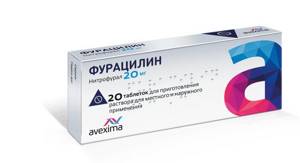
Furacilin.
Stopangin
Main ingredients: anise, mint, hexitidine. Has a powerful antiseptic and antifungal effect. The solution is used in its pure form to rinse the mouth (one tablespoon), twice a day. Use a cotton swab to lubricate the mucous membranes of children. Children from the age of six can be given a rinse solution. Contraindications – early stage of pregnancy, sensitivity. Use between and after meals. The course of treatment is a week.
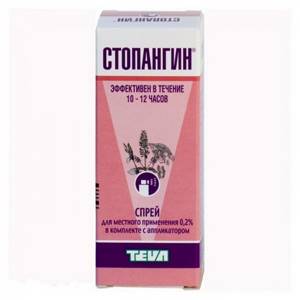
Hexoral
Hexoral is an antiseptic with a pronounced analgesic effect. Compound:
- clove and eucalyptus oil;
- mint;
- anise;
- lemon acid;
- levomenthol;
- hexetidine.
Hexoral is used topically; it is not absorbed into the walls of the mucous membrane, but adheres to it. Due to this, a long-lasting effect is observed. Use after meals.
Dosage:
- Children from six years of age and adults: rinse with the pure solution (15 ml), about 30 seconds, three times a day;
- Children aged 3 to 6 years should consult a pediatrician before use.
Swallowing the solution is prohibited. The course of treatment is discussed with the doctor.
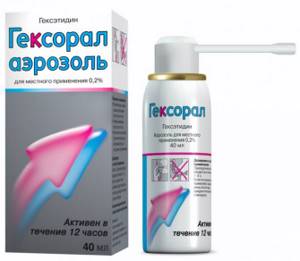
Hexoral.
Chlorhexidine
An effective, affordable product. Consists of two components: water and 20% chlorhexidine digluconate substance. For gargling, the solution should be 0.05%. For medical institutions, the volume is up to 2 liters, for personal use - 100 - 500 milliliters.
Mode of application:
- Pour out the required amount of product;
- Rinse for 30 seconds;
- Carry out rinsing 3 times a day.
Side effects - dark tint of tooth enamel with long-term use of Chlorhexidine.
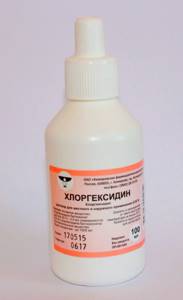
Chlorhexidine.
Gargling with lemon water

Making this home remedy for sore throat couldn't be easier. Lemon juice is an astringent, which means it will shrink the inflamed tissue in your throat. Additionally, lemon juice will increase acidity levels, creating a hostile environment for viruses and bacteria.
Mix 1 teaspoon of freshly squeezed lemon juice with 200 ml of warm water.
Treatment of sore throat and rhinorrhea
Rhinitis, sore throat and pain can be cured through symptomatic and systemic therapy. If the cause of the disease is a viral infection, the doctor prescribes the following to the patient:
- antiviral medicine,
- antipyretic, anti-inflammatory drug,
- nasal drops based on saline solution to moisturize the mucous membrane,
- nasal drops with a vasoconstrictor effect.
Only a doctor can prescribe any medication.
If the cause of the disease is bacterial infection or there is a risk of complications, the patient is prescribed antibiotic drugs for sore throat. You should also consider taking an antibiotic if the temperature exceeds 38 degrees Celsius.

Diseases for which antibiotics are used include: pharyngitis, meningitis, tonsillitis, and the like. If the patient notices that the nasal mucus has acquired a yellow or green color and something like distension is felt in the wings of the nose and in the forehead, then you should not postpone a visit to the otolaryngologist.
A change in the color of snot may be evidence of the attachment of an infectious pathogen and the formation of purulent masses. Similar symptoms, together with a sharp jump in temperature, are inherent in frontal sinusitis or sinusitis.
If the painful condition is a consequence of allergic reactions, the specialist will prescribe antihistamine therapy and advise you to eliminate contact with the irritant.
If during therapy the pain in the throat area has decreased, and the snot does not go away, causing discomfort and leading to impaired nasal breathing, most likely the treatment was chosen incorrectly.
How to gargle with raspberry leaf infusion
Herbal tea made from raspberry leaves is a medicine that is credited with many benefits. To prepare, pour 2 teaspoons of dry or fresh raspberry leaves into 230 ml of boiling water and leave for 10 minutes. After this, strain the infusion and gargle while the mixture is still hot.
If you have a serious illness or persistent pain, you should definitely contact your doctor. Home remedies are suitable for minor complaints, but are in no way a substitute for medical treatment.
Please rate the article!
[Total: 2 Average: 5]
Recipes from traditional medicine
At home, you can gargle using traditional medicine. The most popular recipe is considered to be solutions prepared by mixing beet juice and apple cider vinegar (or using each component separately). The proportions of the gargle in this case are as follows: for two hundred milliliters of beet juice you need to take twenty milliliters of table (9%) or apple cider vinegar.
The resulting remedy helps cure purulent tonsillitis, sinusitis and other manifestations of ARVI.
When the proportions of the components are correct, this medicine is safe, so it can be used along with other rinsing solutions.
But you need to control the amount of vinegar added (so as not to exceed the recommended amount), and also try not to swallow the solution.
It is difficult to say unequivocally what is better to gargle - it all depends on the specifics of the inflammatory process, as well as the individual characteristics of the patient’s body. But, in any case, the patient must periodically visit a doctor who will monitor the treatment process. Even preventive treatment is carried out under the supervision of a specialist.
You should not gargle very often, as this leads to loosening of the tonsils, which means they lose their protective properties. It is also impossible to exceed the maximum permissible number of rinsing procedures per day: no more than five to six times.
Another prerequisite is a variety of rinsing solutions. If you use the same drug or rinse solution for several days in a row, sore throat pathogens develop addiction to it. Therefore, only a doctor can advise what to gargle with a purulent sore throat, based on the specifics of the disease, the age of the patient, as well as the individual characteristics of his body.
Neutralization of acid
Initially, a person who experiences nausea and vomiting, causing discomfort in the throat, needs to reduce the acidity of the juice. This will prevent corrosion of the unprotected mucous membrane. Foods and drinks containing alkali are ideal for such purposes. Best to use:
- Mineral water without gas.
- Water with a small portion of chalk.
- Regular boiled water.
It is highly undesirable to try to reduce the acidity of gastric juice using tap water. It may contain bacteria that the body in this situation is not able to cope with on its own. Therefore, drinking unpurified water is quite capable of causing stomach and intestinal upset.
